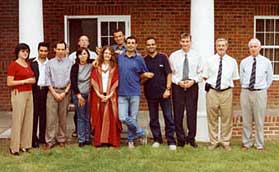Genetic Algorithm: a model applied to freshwater ecology
 Bruna Zendrini from Calabria, Italy has passed successfully her MPhil viva at WIT with a thesis on 'Genetic Algorithm: a model applied to freshwater ecology'.
Bruna Zendrini from Calabria, Italy has passed successfully her MPhil viva at WIT with a thesis on 'Genetic Algorithm: a model applied to freshwater ecology'.
Bruna is the first student to obtain a Masters degree in association with the link agreement between the Wessex Institute of Technology and the Institute for Environment, Ecological and Engineering Studies (EDENET) in Calabria, Italy. The purpose of Bruna's work was to develop a descriptive model for the distribution of macroinvertebrate communities in rivers, with respect to the physical, chemical and biological characteristics of running water ecosystems.
Biomonitoring is the systematic use of organisms and of their responses to determine the quality of the environment. Biotic indices are appropriate to assess the effects of perturbation or dangerous episodes in the history of a river; unfortunately they cannot establish a causal relationship between the modifications in the composition of the communities and the environmental perturbations.
Some relevant causal relationships have been formed between the environmental quality, expressed in terms of the Extended Biotic Indices, and macroindicators, usually employed to assess the health state of freshwater environments. Using data representing the characteristics and the conditions of the biotope, the environmental parameters that are more significant for the distribution of the species were determined.
The mathematical tools used in the work were the Genetic Algorithms: search procedures using random choice as a means to a highly exploitative investigation through a space of parameters. The Genetic Algorithms work with the coding of the parameter set, searching on a population of points and using a payoff (objective function0 to improve the search; the transition rules are probabilistic, not deterministic rules. The objective function describes a problem and the maximum value of the function represents the best solution to the problem. The research looked at the fitness of the individuals, determined through linear regression methods. The environmental data were considered as independent variables and the value of the biologic index expressing the environmental quality was the dependent variable. The corresponding linear equation was solved using a modified regression stepwise method, which inserted or deleted more than one variable at each computational step.
The results will be useful in quantifying the impact of specific activities (agricultural industries, mining industry, industrial activity, urban discharge) on river ecosystems. They may also provide evidence of a connection between biotopes and biocoenosis when used jointly with biotic indices in descriptive studies. Finally, they provide a concise and global evaluation of an ecological relevance about the biotope, when applied as a non-biotic index.


 Wessex Institute
Wessex Institute